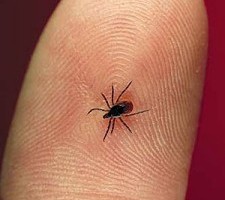In an effort to further educate the public about Lyme disease and other tick-borne illnesses, the PA House of Representatives has passed legislation to create a Lyme disease-specific task force and conduct tick surveillance programs across the state, according to Rep. Tina Pickett, who voted for the measure.
“Across the nation, Pennsylvania continues to rank near the top in terms of Lyme disease diagnoses and other tick-borne diseases,” Pickett said. “Sadly, some people who are bitten by ticks may not even realize they’ve been exposed to the disease, and therefore, our statistics may not be telling the entire story. That’s why we developed this legislation – to raise awareness of the disease and to get a better handle on ticks in our state.”
Lyme disease is a bacterial infection that most people get from the bite of a deer tick. If left untreated, the disease can cause very serious physical and neurological problems that are hard to manage down the road. From 2002 to 2012, state agencies reported a total of 46,178 confirmed cases of Lyme disease.
As part of Senate Bill 177, the task force within the Pennsylvania Department of Health would develop a public education program and coordinate its efforts with the Pennsylvania Game Commission, Department of Conservation and Natural Resources and Department of Education to reach outdoors workers and recreationists, visitors to state parks and students. The task force would investigate and make recommendations to the Health Department regarding surveillance and prevention of Lyme disease as well as development of a general public and health care professional information and education program.
Early diagnosis is also important in fighting Lyme disease. Most cases of the disease can be treated successfully with antibiotics, especially if treatment is started early enough. However, left untreated or inadequately treated, the infection can spread to joints, the heart, and the nervous system, resulting in increasingly serious complications and requiring intensive therapy.
Lyme disease can infect several different parts of the body making diagnosis difficult. Symptoms often vary from person to person. However, typical symptoms include fever, headache, fatigue and a characteristic circular skin rash called Eythema Migrans (EM). EMs are usually the first sign of infection and occur at the site of the tick bite. The rash, which occurs in approximately 85 percent of infected persons, is normally evident after a delay of three to 30 days. In addition, one of the distinctive characteristics of EMs is that they gradually expand over the course of several days and can reach nearly 12 inches in diameter.
With the House making a few technical changes to the bill, the legislation heads back to the Senate for concurrence before going to the governor.
In the meantime, Pickett advises everyone – especially those who spend any amount of time outdoors – to avoid tick-infested habitats, including heavily wooded areas, tall grass and other area where deer may frequent. If that is not possible, individuals should take precautions and wear protective clothing, including long sleeves and pants; use insect repellents; and check themselves, their children and their pets for ticks following outdoor activities.
Pickett’s district offices in Towanda and Athens offers an informational brochure that includes symptoms and signs of the disease, as well as a list of resources for people to contact, including the Lyme Disease Association, support groups and the state Department of Health.


